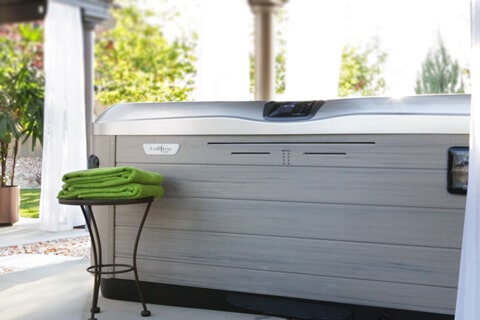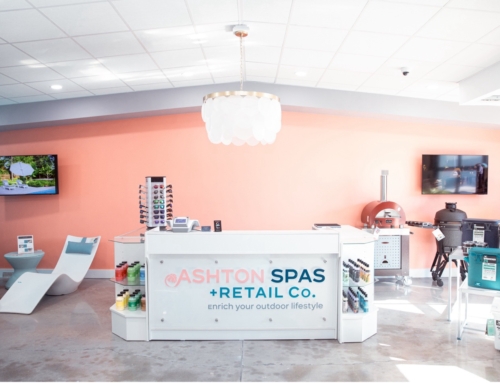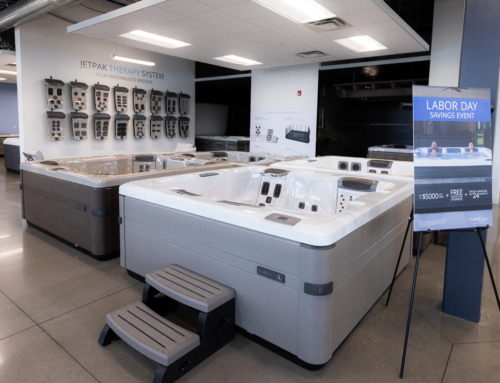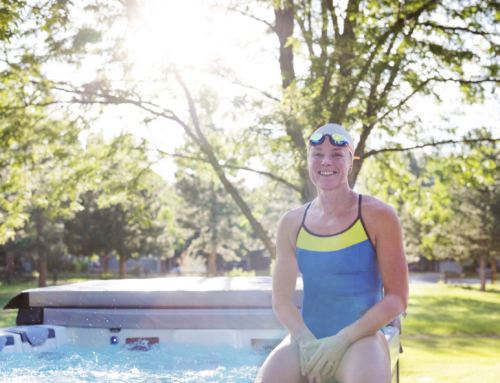How can one hot tub customer make much more of a bottom-line impact than another? Well, there are basically two ways. Either spend more in each purchase or buy more frequently.

Get Your Spas Included in the Contractor’s Designs & Plans
There are myriad reasons to be a part of the spa retail game. When you make a sale, you’re offering your customers a high-quality product that brings them joy. And as long as you’re a dealer for a quality product line, you’re able to take a good margin. However, a big challenge in this business is that quality spas tend to go strong for years, easily a decade or more. Your customers are happy, but they are out of the purchase consideration stage for long stretches. You are constantly forced to find and attract new customers, a difficult and costly endeavor.
So what’s the answer? How does a spa retailer overcome this challenge and keep orders coming in consistently? Any experienced salesperson will agree that new customers create the steam that will push your revenue engine up the hill. But the key here is prospecting in a way that yields the most possible sales per contact. In short, attracting a customer that buys more often is a better investment that yields more revenue over time. This is why each contractor customer is pure gold.
How Contractor Partnerships Work
It’s easy to focus all your energy on marketing direct to end consumers in order to grow the business. Yes, these sales are important. They are the people enjoying the product and it’s critical to build lifelong trust and good relationships, but marketing this way usually results in one to three sales per customer per lifetime. Instead, Bullfrog Spas Marketing Director Dan Sjoblom stresses the effectiveness of contractor partnerships: “Working with contractors creates a recurring revenue stream, so it’s critical to your success.”
Partnerships are a goldmine, and they lead to a lot of repeat business—sales of the spas themselves as well as maintenance, chemicals, and so on.
Partnership with contractors is a different ball game. It’s the difference between reaching one new client at a time and reaching a new partner who has a solid booking of regularly buying clients. In short, the volume potential of your contractor partners equals revenue, and more stability for your business. Spa sales manager Jeff Robinson of Dolphin Pools and Spas in Salt Lake City, UT, a spa dealer for nearly 40 years, says that contractor partnerships are great in the long run.
“Partnerships are a goldmine, and they lead to a lot of repeat business—sales of the spas themselves as well as maintenance, chemicals, and so on.” Robinson has secured partnerships with several contractors who build and manage vacation homes in Summit County, Utah, an area known for tourism and high income demographics. These partnerships bring in a consistent stream of new clients who are eager to buy.
Contractor partnerships are all about setting up a situation that works double-time for everyone in the mix, from you and your contractor all the way down to the customer. It’s a simple strategy of taking stock of each partner’s resources and needs to create a mutually beneficial situation.
By offering your spas to a contractor at a discount, for example, you can give the builder great pricing while ensuring that they’ll order a set number of units over a period of time. This is a long-term relationship that plays on the strength of your product to help both you and the contractor reach more customers.
In the end, a good partnership comes down to communication and mutual satisfaction.
From a sales perspective, this kind of relationship demands that you build trust with one point of contact—the contractor, who has in turn built trust with each of his own clients—instead of starting from scratch with multiple fresh, one-off clients. It’s a system that puts the contractor’s relationships to work for you, cutting down on your time and cost of reaching out to new prospects directly.
Customers with Partnership Potential
One of the biggest challenges in any line of business is locking down those golden clients who keep coming back for more. But the opportunity for spa dealers is there. This year, industry analysts estimate outdoor living spending to top a record $5.7 billion. And contractors can be the gatekeeper to a larger chunk of this market than retailers might realize on their own.
Here’s a basic list of professionals who could benefit from buying spas for their projects.
- Architects
- Landscapers
- Landscape architects
- New home builders
- Remodel contractors
- Custom home builders
 Architects, landscapers, and landscape architects usually have access to higher-budget clients. A positive relationship may mean that they begin to build space for hot tubs directly into their designs.
Architects, landscapers, and landscape architects usually have access to higher-budget clients. A positive relationship may mean that they begin to build space for hot tubs directly into their designs.
Builders for production or development homes churn out new properties all the time, and with more people opting to build again. Partnering with the builder at a development, some of which may even be multiple-unit projects like time-share complexes and 55 and over communities, can lead to volume sales. You may even gain access to entire new subdivisions that can serve as a de facto showroom as neighbors mingle and chat with one another about the new spa that came from your store.
Custom home builders are a rich resource for partnerships not only because of the potential for repeat business, but also because custom buyers typically have the budget for higher-end hot tubs. For a high success rate, think about builders who specialize in vacation or recreation properties—home owners in this space almost always have a spa in mind.
Turning that Partnership Potential into Revenue
Even after you have begun working a strong list of contractors, you’ll need to continually research fresh projects going on in your area. Sjoblom recommends dividing contractors into groups, like the list above. “Each type of contractor will see value in different services, discounts, or programs you offer.” And since they may want something a little different, it’s important to think through your potential offer for each before you pitch.
Sjoblom adds, “For example, custom builders will be interested in your product’s quality and the long-term relationship they’ll have with you. They can give their clients peace of mind that they’ll be able to get a good price and excellent quality.”
If a developer or condo complex is your aim, think about how you can provide deep deals on bulk standard units. Architects and landscapers, however, may want to know the different product range you offer for their various types of individual clients. What would work for a newly retired couple renovating a backyard into their own private sanctuary might not necessarily be the best option for a family of five looking to capitalize on their family and friend time.
Prospecting New Partnerships
Rick Specht of Pool to Spa Services in Wenatchee, WA has found it helpful to start small. Great relationships don’t happen overnight, so devote a set time in your schedule to prospecting new partnerships. Be familiar with market dynamics in each of your contractor categories, and create a smooth presentation tailored to each contractor type. Show how your product builds value to the end customer and how you can provide an excellent incentive to your contractor.
...rapport goes a long way. Once you have that going, the spas get sold without you doing a thing.
Think about marketing dynamics and ask yourself, “How do I become the spa dealer that the contractor selects?” When potential partners are ready to hear you, create a solid, polished presentation and show simply how you can add value to what they provide for their customers. “With the market research and planning behind you, when it’s time to pick up the phone or knock on doors, the process will be smoother and your presentation will be a lot cleaner,” says Sjoblom.
Once you’ve landed some ideal partnerships, stay part of the conversation throughout the process. Rick Specht of Pool to Spa Services emphasizes that communication is key when partners combine efforts, particularly to ensure expectations are met by all parties involved. Special attention to costs and timeframes serve as another important perk that will impress your contractor clients, giving you a better chance at recurring sales.
Robinson advises spa dealers to visit contractors and drop off new brochures, or even just say hello. “Have really good customer service and really good communication,” says Robinson. “Keep the contractor involved during every step of the process, not just when the sale is made. That rapport goes a long way. Once you have that going, the spas get sold without you doing a thing.”
Partnerships versus Referrals
It’s crucial to understand the difference between contractor partnerships and referral rewards programs. Sjoblom throws a word of caution: “Probably the biggest mistake I see happening is that people confuse contractor partnerships with referral programs. You need a strong referral incentive to reward professionals who send people your way, but the contractor partnership is more than that. It’s a long-term business relationship with some kind of specified value that becomes part of your deal with that specific contractor over time. It’s a volume program.”
It’s crucial to understand the difference between contractor partnerships and referral rewards programs.
Partnerships and referrals both have their strengths in keeping your business moving. But it’s important to understand where to apply each type of program and where you’ll find the most potential for ongoing revenue.
If a part-time handyman is building a deck for his neighbor and sends the client to you to purchase a spa, a referral reward would keep up the contractor’s incentive to send more people to you down the line. If that same handyman has a dozen similar deck projects booked for the season, reach out to him about creating a program that gets him an excellent deal on buying spas directly from you, provided that he purchases a set number of units for the season.
By feeling out the recurring sales potential for each contractor, you’ll begin to piece together an appropriate program for each contractor you work with. Keep your programs customized, and offer an incentive or program that will suit everyone’s situation.
In the end, a good partnership comes down to communication and mutual satisfaction. Always get a feel for each contractor’s unique needs before pitching a partnership program, and make sure you’re creating a system that pays off for everyone. When you work to create strong connections that yield ongoing fruit, you ensure a consistent flow of repeat sales that will grow your business and solidify your reputation.









Leave A Comment